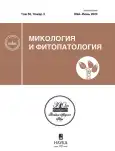Root-associated mycobiota of Goodyera repens (Orchidaceae) populations from three Russian regions
- Авторлар: Bibikov N.М.1, Voronina E.Y.1, Kurakov А.V.1
-
Мекемелер:
- Lomonosov Moscow State University
- Шығарылым: Том 58, № 3 (2024)
- Беттер: 195-204
- Бөлім: БИОРАЗНООБРАЗИЕ, СИСТЕМАТИКА, ЭКОЛОГИЯ
- URL: https://journals.rcsi.science/0026-3648/article/view/265120
- DOI: https://doi.org/10.31857/S0026364824030025
- EDN: https://elibrary.ru/vjaebw
- ID: 265120
Дәйексөз келтіру
Толық мәтін
Аннотация
Goodyera repens is an orchid, widespread and abundant in the coniferous forests of the northern hemisphere. Along with other members of Orchidaceae, in natural conditions it exists in obligate mycorrhizal symbiosis. Despite a long history of study, no data on the mycobiota associated with the root system of this species have been obtained for populations growing in Russia. It is therefore necessary to assess the entire diversity of fungal associates, including non-cultivated species, as well as to obtain quantitative characteristics and evaluate the geographic specificity of fungal communities. In this work, the mycobiota of the root system of G. repens growing in the Leningrad and Moscow Regions and Karachay-Cherkess Republic was analysed qualitatively and quantitatively for the first time using high-throughput sequencing. A total of 438 operational taxonomic units were identified, with the majority belonging to the subdivision Basidiomycota. The quantitative predominance of sequences of the genera Russula, Ceratobasidium, Piloderma, Mycena, and Tomentella was observed. Significant differences between fungal communities of soil and the root system of G. repens were established in all studied regions. The regional specificity of the taxonomic composition of the mycobiota was demonstrated. The taxa spectrum of the samples from Karachay-Cherkessia differed significantly from that of the Leningrad and Moscow Regions, while no notable difference was observed between the latter two. With regard to the distribution of ecological groups of fungi, no significant differences were found between the regions.
Негізгі сөздер
Авторлар туралы
N. Bibikov
Lomonosov Moscow State University
Хат алмасуға жауапты Автор.
Email: bibik0808@mail.ru
Ресей, Moscow
E. Voronina
Lomonosov Moscow State University
Email: mvsadnik@list.ru
Ресей, Moscow
А. Kurakov
Lomonosov Moscow State University
Email: kurakov57@mail.ru
Ресей, Moscow
Әдебиет тізімі
- Averyanov L.V. Orchidaceae of Middle Russia. Turczaninowia. 2000. V. 3 (1). P. 30–53 (in Russ.).
- Cameron D.D., Leake J.R., Read D.J. Mutualistic mycorrhiza in orchids: evidence from plant-fungus carbon and nitrogen transfers in the green-leaved terrestrial orchid Goodyera repens. New Phytol. 2006. V. 171 (2). P. 405–416. https://doi.org/10.1111/j.1469-8137.2006.01767
- Costantin J., Dufour L. Sur la biologie du Goodyera repens. Rev. Gen. Bot. 1920. V. 32. P. 529–533.
- Downie D.G. Source of the symbiont of Goodyera repens. Trans. R. Soc. Edinburgh. 1943. V. 33. P. 383–390. https://doi.org/10.1080/13594864309441392
- Fuller G.D. Symbiosis in orchids. Bot. Gaz. 1909. V. 48 (6). P. 474. https://doi.org/10.1086/330075
- GenBank. National Center for Biotechnology Information. 2023. https://www.ncbi.nlm.nih.gov/genbank. Accessed 16.08.2023.
- Girlanda M., Selosse M.A., Cafasso D. et al. Inefficient photosynthesis in the Mediterranean orchid Limodorum abortivum is mirrored by specific association to ectomycorrhizal Russulaceae. Mol. Ecol. 2006. V. 15 (2). P. 491–504. https://doi.org/10.1111/j.1365-294X.2005.02770.x
- Li Y.Y., Boeraeve M., Cho Y.H. et al. Mycorrhizal switching and the role of fungal abundance in seed germination in a fully mycoheterotrophic orchid, Gastrodia confusoides. Front. Plant Sci. 2022. V. 12. P. 1–12. https://doi.org/10.3389/fpls.2021.775290
- Maevskiy P.F. The flora of Middle European Russia. 11th edn. Tovarishchestvo nauchnykh izdaniy KMK, Moscow, 2014 (in Russ.).
- Martin F., Kohler A., Murat C. et al. Unearthing the roots of ectomycorrhizal symbioses. Nat. Rev. Microbiol. 2016. V. 14 (12). P. 760–773. https://doi.org/10.1038/nrmicro.2016.149
- Martino E., Morin E., Grelet G.A. et al. Comparative genomics and transcriptomics depict ericoid mycorrhizal fungi as versatile saprotrophs and plant mutualists. New Phytol. 2018. V. 217 (3). P. 1213–1229. https://doi.org/10.1111/nph.14974
- MycoBank Database. https://www.mycobank.org/. Accessed 16.08.2023.
- Nguyen N.H., Song Z., Bates S.T. et al. FUNGuild: an open annotation tool for parsing fungal community datasets by ecological guild. Fungal Ecol. 2016. V. 20. P. 241–248. https://doi.org/10.1016/j.funeco.2015.06.006
- Oberwinkler F., Cruz D., Suárez J.P. Biogeography and ecology of Tulasnellaceae. In: L. Tedersoo (ed.). Biogeography of mycorrhizal symbiosis. Berlin: Springer. 2017. P. 237–271.
- Pilshchikova N.S., Gannibal Ph.B. Modern systematics of the genus Rhizoctonia sensu lato. Mikologiya i fitopatologiya. 2016. V. 50 (2). P. 75–88 (in Russ.).
- Põlme S., Abarenkov K., Henrik Nilsson R. et al. FungalTraits: a user-friendly traits database of fungi and fungus-like stramenopiles. Fungal Divers. 2020. V. 105. P. 1–16. https://doi.org/10.1007/s13225-020-00466-2
- Roberts P. Thanatephorus ochraceus: a saprotrophic and orchid endomycorrhizal species. Sydowia. 1998. V. 50. P. 252–256.
- Shefferson R.P., Cowden C.C., McCormick M.K. et al. Evolution of host breadth in broad interactions: mycorrhizal specificity in East Asian and North American rattlesnake plantains (Goodyera spp.) and their fungal hosts. Mol. Ecol. 2010. V. 19. P. 3008–3017. https://doi.org/10.1111/j.1365-294X.2010.04693.x
- Smith S., Read D. Mycorrhizal symbiosis. Tovarishchestvo nauchnykh izdaniy KMK, Moscow, 2012 (in Russ.).
- Suetsugu K., Yamato M., Miura C. et al. Comparison of green and albino individuals of the partially mycoheterotrophic orchid Epipactis helleborine on molecular identities of mycorrhizal fungi, nutritional modes and gene expression in mycorrhizal roots. Mol. Ecol. 2017. V. 26 (6). P. 1652–1669. https://doi.org/10.1111/ijlh.12426
- UNITE. 2022. https://unite.ut.ee/index.php. Accessed 16.08.2023.
- Voronina E.Y., Malysheva E.F., Malysheva V.F. et al. A mixo-trophy is in question: new data on fungal community associated with photosynthetic terrestrial orchid Goodyera repens. Bot. Pac. 2018. V. 7. P. 51–61. https://doi.org/10.17581/bp.2018.07106
- Wang D., Lerou J., Nuytinck J. et al. Root-associated fungi in Orchidaceae: Diversity, phylogeny, ecology, and outstanding questions. BioRxiv. 2022. https://doi.org/10.1101/2022.12.16.519622
- Weiß M., Waller F., Zuccaro A. et al. Sebacinales – one thousand and one interactions with land plants. New Phytol. 2016. V. 211. P. 20–40. https://doi.org/10.1111/nph.13977
- Аверьянов Л.В. (Averyanov) Орхидные (Orchidaceae) Средней России // Turczaninowia. 2000. Т. 3 (1). С. 30–53.
- Маевский П.Ф. (Maevskiy) Флора средней полосы европейской части России. 11-е изд. М.: Товарищество научных изданий КМК, 2014.
- Пильщикова Н.С., Ганнибал Ф.Б. (Pilshchikova, Gannibal) Современная систематика грибов рода Rhizoctonia sensu lato // Микология и фитопатология. 2016. Т. 50 (2). С. 75–88.
- Смит С., Рид Д. (Smith, Read) Микоризный симбиоз. М.: Товарищество научных изданий КМК, 2012.
Қосымша файлдар









